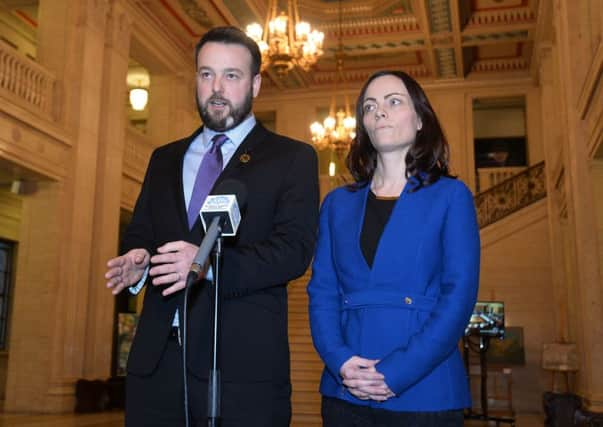Careful Colum '“ the SDLP's obliteration may be at hand


Why is this happening? The answer lies in the changes made to the Good Friday Agreement at St Andrews in 2006/7.
The partnership model for Stormont, negotiated during the Mitchell process in 1996-1998, resulted in the First Minister and Deputy First Minister coming from the largest designations in the Assembly, either unionist or nationalist. They had to be elected by the Assembly in a joint resolution on a cross-community vote.
Advertisement
Hide AdAdvertisement
Hide AdThis provided each designation with a veto over the other, but gave legal and symbolic expression to the interdependence of one section of the community upon the other.
This underpinned the necessity for partnership working, and was endorsed in the 1998 referendum on the Agreement by 71.2% of voters.
However, fast forward to 2006 and St Andrews.
The Assembly was stalled over the decommissioning issue, amongst others. And without consultation or consent from the parties that negotiated the Agreement, the Government decided to amend the legislation under which Stormont functioned, to eliminate the joint vote in the Assembly for First and Deputy First Ministers, ignore the designations of nationalist and unionist, and simply identify the First Minister from the largest party in the Assembly following the election.
This change, widely underestimated for its significance, totally altered the dynamics of Assembly elections.
Advertisement
Hide AdAdvertisement
Hide AdThe concept of dependent partnership was replaced by a first-past-the-post race to see who would be First Minister (even though there is no legal difference between the First and Deputy First Ministers). The main reason for this was to accommodate Ian Paisley who did not want to have to be elected First Minister on a joint resolution with Martin McGuinness!
Ironic as they went onto become the ‘chuckle brothers’, but it allowed Ian and his successors to argue at subsequent elections that if unionists didn’t vote for him or his party Martin McGuinness would become First Minister! This change, therefore, created the political silos which we can now see clearly demonstrated during the RHI hearings and which has ultimately led to Stormont’s collapse.
Why is this relevant to the SDLP Fianna Fail talks?
The reason is of course that this change ensured that all Assembly elections became sectarian headcounts, and the parties of the centre who espoused partnership were severely weakened.
Both London and Dublin governments knew that this was going to happen, but they felt then that by bringing in the ‘two extremes’ it would lead to a more stable Stormont! So much for that idea, as events have sadly confirmed. A further irony was that it was a Fianna Fail government that endorsed these proposals, knowing that it would damage the SDLP as well as the Ulster Unionists.
Advertisement
Hide AdAdvertisement
Hide AdIn elections after that, both centre parties struggled and the SDLP looked to Dublin and Fianna Fail to give them ‘all Ireland credentials’ so they could challenge Sinn Fein, who made much of the fact they were an all-island party.
The loss of the SDLP’s seat in the European Parliament was a very bitter blow for them as they were proud of their pan-European connections through the socialist group in the Brussels Parliament.
The SDLP however, has always had a fault line – that between the ‘greener’ element based in Londonderry and the ‘more labour’ orientated members based in Belfast.
This was visible when the idea was first mooted nine years ago, and again today with comments from councillor Tim Attwood and MLA Claire Hanna.
Advertisement
Hide AdAdvertisement
Hide AdThe fear – and indeed the reality – is that ‘working together’ becomes a merger, which becomes the obliteration of the SDLP brand locally.
There may be some short-term gains insofar as FF may appoint some senior SDLP figure to the Irish Senate, perhaps give them a shot at one of the additional seats the Republic will have in Brussels after Brexit – but the danger is that many nationalists, whatever their protestations, are not really focused on day to day Dublin politics and would have no ability to implement the socio-economic policies upon which FF must fight and win future Irish elections.
It is all borne out of electoral weakness which is directly linked to the St Andrew’s changes but may not give Colm Eastwood and his colleagues the relief for which they hope.
There are some parallels with the UUP-Conservative arrangement [officially called “Ulster Conservatives and Unionists – New Force”, or UCUNF]. But it is also different.
Advertisement
Hide AdAdvertisement
Hide AdWe were trying to resume a link that had been operating for 80 years before it broke down after the Anglo Irish Agreement. The SDLP have no such history.
I was concerned that in 2009 it looked as if all nationalist parties would be linked to Dublin, while no unionists were linked to London.
We were thwarted in part by the small rump of NI Tories who did not like the idea of teaming up with the UUP, as they thought we were too sectarian. Look at where they are now, and who is propping them up. The DUP lambasted us, but look at them now!
Sooner or later FF will play the big brother card to push for a merger. We had a long history of independent action as a regional party; FF is much more centralised.
Colum will need to watch himself.
• Lord Empey is a UUP peer, and led the party from 2005 to 2010